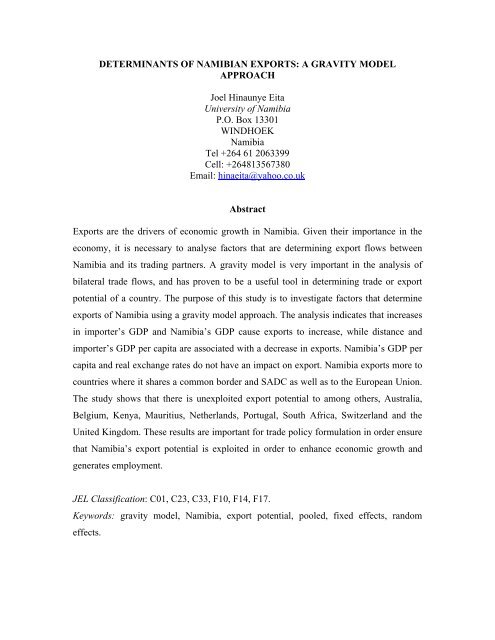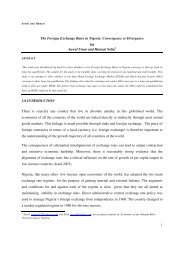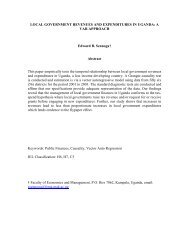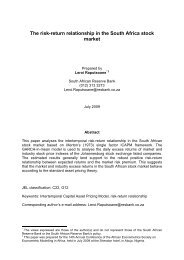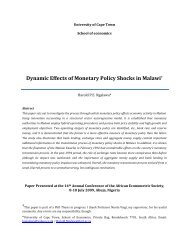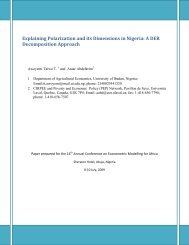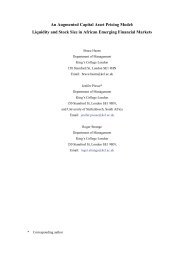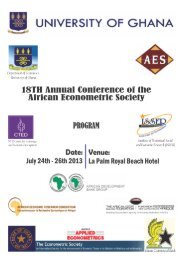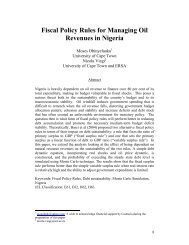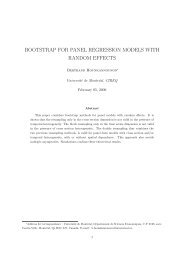a gravity model approach - African Econometric Society
a gravity model approach - African Econometric Society
a gravity model approach - African Econometric Society
You also want an ePaper? Increase the reach of your titles
YUMPU automatically turns print PDFs into web optimized ePapers that Google loves.
DETERMINANTS OF NAMIBIAN EXPORTS: A GRAVITY MODELAPPROACHJoel Hinaunye EitaUniversity of NamibiaP.O. Box 13301WINDHOEKNamibiaTel +264 61 2063399Cell: +264813567380Email: hinaeita@yahoo.co.ukAbstractExports are the drivers of economic growth in Namibia. Given their importance in theeconomy, it is necessary to analyse factors that are determining export flows betweenNamibia and its trading partners. A <strong>gravity</strong> <strong>model</strong> is very important in the analysis ofbilateral trade flows, and has proven to be a useful tool in determining trade or exportpotential of a country. The purpose of this study is to investigate factors that determineexports of Namibia using a <strong>gravity</strong> <strong>model</strong> <strong>approach</strong>. The analysis indicates that increasesin importer’s GDP and Namibia’s GDP cause exports to increase, while distance andimporter’s GDP per capita are associated with a decrease in exports. Namibia’s GDP percapita and real exchange rates do not have an impact on export. Namibia exports more tocountries where it shares a common border and SADC as well as to the European Union.The study shows that there is unexploited export potential to among others, Australia,Belgium, Kenya, Mauritius, Netherlands, Portugal, South Africa, Switzerland and theUnited Kingdom. These results are important for trade policy formulation in order ensurethat Namibia’s export potential is exploited in order to enhance economic growth andgenerates employment.JEL Classification: C01, C23, C33, F10, F14, F17.Keywords: <strong>gravity</strong> <strong>model</strong>, Namibia, export potential, pooled, fixed effects, randomeffects.
Although empirical research on the export of Namibia is limited, there is one notablestudy by Jordaan and Eita (2007). This study indicates that export is the key to economicgrowth in Namibia, and the country can expand its limited domestic market by exportingto the international markets. Given this importance and the role it plays in the Namibianeconomy, it is important to investigate the factors influencing exports and determinetrade (export) potential to different countries. A useful tool in the determination of theexport potential of a country is a <strong>gravity</strong> <strong>model</strong>. The <strong>model</strong> has its foundations in physicalscience and has become an important tool in the analysis of bilateral trade flows.Tinbergen (1962) and Poyhonen (1963) pioneered the idea of explaining trade flows inanalogy to Newtons’s law of <strong>gravity</strong> by the attraction of two countries’ masses, weakenedby distance between them and enforced by trade agreements they belong to. The massesof countries are measured by GDP or population, and transport costs are proxied by thedistance between countries. As in physical science, the bigger and closer the units are toeach other, the stronger the attraction. The analogy with <strong>gravity</strong> derives from GDP beinga measure of economic mass and distance as a measure of resistance. The <strong>gravity</strong> <strong>model</strong>is used to investigate the relationship between the volume and the direction ofinternational trade and the formation of regional trade blocks. The <strong>model</strong> is augmentedwith a number of variables to test whether they are relevant in explaining trade flowsbetween countries. These variables include GDP, distance, infrastructure endowment,differences in per capita income and exchange rate (Eita and Jordaan, 2007).In light of the above, the objective of this paper is to investigate factors determiningNamibian exports for the period 1998 to 2006 using the <strong>gravity</strong> <strong>model</strong>. The paper then
investigates whether there is unexploited trade potential among Namibia’s tradingpartners. There rest of the paper is organised as follows. Section 2 discusses the <strong>gravity</strong><strong>model</strong>. Section 3 discusses the estimation procedure and Section 4 presents the univariatecharacteristics of the data. The estimation results and potential exports are presented inSections 5 and 6. Section 7 concludes.2. The <strong>gravity</strong> <strong>model</strong>The <strong>gravity</strong> <strong>model</strong> was first applied to international trade in the early 1960s. Amongothers, Pöyhönen (1963) was the first to apply the <strong>gravity</strong> <strong>model</strong> to international trade. Inthe latter half of the twentieth century, the <strong>gravity</strong> <strong>model</strong> has been used to explainmigration and other social flows in terms of gravitational forces of human interaction.Like in physical science, the bigger and closer the units are to each other, the stronger theattraction. The comparison with <strong>gravity</strong> derives from gross domestic product (GDP)being a proxy for economic mass and distance a proxy for resistance.The <strong>gravity</strong> <strong>model</strong> performed well in analysing the international trade flows in the early1960s but strong theoretical foundations were not produced until the end of the 1970s.This led to many studies to modify the original Newtonian <strong>gravity</strong> equation. From theworks of Anderson (1979) and Bergstrand (1985, 1989) it became clear that the <strong>gravity</strong>equation is a good representation irrespective of the structure of product markets.Bergstrand (1985, 1989) included population size while Oguledo and Macphee (1994)included price variables.
whereα ij represents individual effects, SADC is the dummy variable taking the value ofone if the country is a member of SADC and zero otherwise, and EU is the dummyvariable for countries that are part of the European Union and takes the value of one ifpart of EU or zero otherwise. BORDER is a dummy variable for countries that shareborders with Namibia. It also takes the value of one and zero otherwise. According toCarrère (2006) membership of regional groupings can generate a significant increase intrade. The coefficient of the real exchange rate is expected to be negative, implying thatan appreciation of the real exchange rate discourages exports, while those of dummyvariables are expected to be positive. Regional trade agreements and sharing a commonborder promote exports between countries.3. Estimation ProcedureThere are three <strong>model</strong>s that can be estimated in panel data estimation. These <strong>model</strong>s are pooled, fixedeffects and random effects. Since individual effects are included in the regressions a decision shouldbe made whether they are treated as random or fixed. A random effects <strong>model</strong> can be moreappropriate when estimating the flows of trade between a randomly drawn sample of trading partnersfrom a large population. A fixed effects <strong>model</strong> would be a better <strong>model</strong> when estimating the flows oftrade between an ex ante predetermined selection of countries (see Egger, 2000; Eita and Jordaan,2007). Since this study deals with the flows of trade between Namibia and its 38 main tradingpartners, the fixed effect will be a more appropriate <strong>model</strong> than the random effect specification. Thetop 38 trading partners were selected based on trade statistics for the period 1998 to 2006.Furthermore, the study also applies the Hausman test to check whether the fixed effects <strong>model</strong> is moreefficient than the random effects <strong>model</strong>. This will be true if the null hypothesis of no correlationbetween the individual effects and the regressors is rejected.
The main problem with a fixed effects <strong>model</strong> is that variables that do not change over time cannot beestimated directly because the inherent transformation wipes out such variables. These variables asMartinez-Zarzoso and Nowak-Lehman (2001) stated can be estimated in a second step by runninganother regression with the individual effects as the dependent variable and distance and dummies asexplanatory variables. This is estimated as:FE µij = α 0 + α1Dij+ α 2BORDER+ α 3SADC+ α 4 EU + i(6)whereFE ijdenotes individual effects, and other variables are as defined before.4. Univariate Characteristics of the DataData sources and countries included in the estimation are presented in the Appendix. Beforeestimating Equation (5), the study analysed the univariate characteristics of the data which entailspanel unit root tests. Unit root test is the first step in determining a potentially cointegratedrelationship between the variables. If all variables are stationary, then the traditional estimationmethods can be used to estimate the relationship between the variables. If the variables arenonstationary a test for cointegration is required. There are different types of panel unit roots tests.The first test is the one of Levin, Lin and Chu (2002) and the second is that of Hadri (2000). The twotests of panel unit roots assume that the autoregressive parameters are common across countries.Levin, Lin and Chu (2002) which is also referred to as LLC uses a null hypothesis of a unit root, whilethat of Hadri (2000) uses a null of no unit root.A third test is referred to as the IPS test developed by Im, Pesaran and Shin (2003). It allows theautoregressive parameters to vary across countries and also for individual unit root processes. It is
computed by combining individual countries’ unit root tests in order to come up with a result that isspecific to a panel. It has more power than the single-equation Augmented Dickey Fuller (ADF) byaveraging N independent ADF regressions (Straus and Yigit, 2003: 309). The ADF tests specificationmay include an intercept but no trend or may include an intercept and time trend. The null hypothesisis that all series contain a unit root and the alternative is that at least one series in the panel contain aunit root. IPS is a one-tailed or lower tailed test based on the N(0,1) distribution. The IPS and LLC areapplied in this study and test results are presented in Table A1 in the Appendix. The IPS test resultsshow that only importer’s GDP per capita and real exchange rate are stationary. The other variablesare non-stationary. The LLC test results indicate that all variables are stationary (null of unit root isrejected). The study uses rejection of unit root by at least one test to assume a verdict of stationarity.This implies that cointegration test is not required and ordinary least squares method can be used toestimate Equation (5).5. Estimation ResultsThe estimation results are presented in Table 1. The results of the pooled <strong>model</strong> are inthe second column, while those of fixed effects and random effects <strong>model</strong>s are in thirdand fourth columns. The main problem of the pooled <strong>model</strong> is that it does not allow forheterogeneity of countries. It does not estimate country specific effects and assumes thatall countries are homogenous. It is a restricted <strong>model</strong>.Fixed effects <strong>model</strong> introduces heterogeneity by estimating country specific effects. It isan unrestricted <strong>model</strong> as it allows the intercept and other parameters to vary acrosstrading partners. The F-test statistic was performed to test whether countries are poolableand the results indicates that the null hypothesis of equality of individual effects isrejected. This means that a <strong>model</strong> with individual effects must be selected.
Like the fixed effects, the random effects <strong>model</strong> also acknowledges heterogeneity in thecross-section. However, it differs from the fixed effects <strong>model</strong> in the sense that the effectsare generated by a specific distribution. Although it assumes that there is heterogeneity inthe cross-section, it does not <strong>model</strong> each effect explicitly. This prevents the loss ofdegrees of freedom which happens in fixed effects <strong>model</strong>. The LM test was performedand the null hypothesis of equality of the individual effects is rejected in favour ofrandom effect specification.The Hausman statistic is used to test the null hypothesis that the regressors and individualeffects are not correlated in order to distinguish between fixed effects <strong>model</strong> and randomeffects <strong>model</strong>. Failure to reject the null hypothesis implies that the random effects <strong>model</strong>will be preferred. If the null hypothesis is rejected, the fixed effects <strong>model</strong> will beappropriate. The Hausman test statistic shows that the null hypothesis is rejected and thisindicates that country specific effects are correlated with regressors. This suggests thatthe fixed effects <strong>model</strong> is appropriate, and the random effects estimates are notconsistent. Since the fixed effects <strong>model</strong> is the appropriate one, interpretation of theresults will focus on the fixed effects <strong>model</strong>.
Table 1. Estimation ResultsDependent variable: ExportVariables Pooled <strong>model</strong> Fixed Effects Random EffectsModelConstant 29.080 (2.154)** 32.634 (3.192)*** 26.339 (2.563)**Importer’s GDP 0.622 (8.470)*** 0.776 (1.829)* 0.558 (3.377)***Namibia’s GDP 2.470 (1.285) 3.44 (2.549)** 2.714 (2.066)**Importer’s GDP per 0.387 (4.588)*** -1.220 (-2.463)** 0.1254 (0.658)capitaNamibia’s GDP per -2.259 (-0.679) -2.749 (1.216) -2.387 (-1.059)capitaReal exchange rate 1.476 (0.538) 1.088 (0.584) 1.396 (0.751)Distance -1.634 (-5.203)*** -0.922 (1.288)Border 0.947 (1.914)* 1.793 (1.524)EU 1.584 (5.627)*** 1.994 (2.946)***SADC 0.788 (2.409)** 0.612 (0.761)Adjusted R-squaredF-testLM testHausman testNotes. ***/**/* significant at 1%/5%/10% level.t-statistics are in parentheses.0.509 0.77423.063***255.009***0.577363.634***The results show that an increase in increase in the importer’s GDP and Namibia’s GDPcauses an increase in Namibia’s exports. The coefficients for the two variables arepositive and statistically significant. They are consistent with theoretical expectation.Although the coefficient of importer’s GDP per capita is positive in the pooled andrandom effects <strong>model</strong>, it is negative in the fixed effects <strong>model</strong>. This indicates that anincrease in the GDP per capita of the importing country causes Namibian exports todecrease. Increase in Namibia’s GDP per capita also causes exports to decrease, but thecoefficient is not statistically significant. This suggests Namibia’s GDP per capita has nosignificant impact on exports. Namibia’s real exchange rate has an insignificantcoefficient, implying that it does not have an impact on exports.
Table 2. Second stage regression resultsDependent variable: individual effectsExplanatory variablesCoefficient (t-statistics)Border 3.224 (16.448)***Distance -0.140 (-40.240)***EU 3.896 (122.851)***SADC 0.814 (2.75)**Adjusted R-squared 0.988***/** Significant at 1%/5% level.6. Potential ExportsThe estimated fixed effects <strong>model</strong> of Equation (5) is solved in order to determine thewithin sample potential exports of Namibia (see Eita and Jordaan, 2007). Potentialexports are compared to actual exports in to determine if there is unexploited exportpotential. Figure 1 presents potential and actual exports. There is unexploited exportpotential to among others, Australia, Belgium, Kenya, Mauritius, Netherlands, Portugal,South Africa, Switzerland and the United Kingdom.Figure 1. Trade Potential (in USA dollars)AustraliaBelgium1600000045000000140000004000000012000000350000001000000030000000800000060000004000000200000002500000020000000150000001000000050000000199819992000200120022003200420052006ActualPotentialActualPotential
KenyaMauritius160000014000001200000100000080000060000040000020000009000008000007000006000005000004000003000002000001000001998199920002001200220032004200520060199819992000200120022003200420052006ActualPotentialActualPotentialNetherlandsPortugal
80000000700000006000000050000000400000003000000020000000100000000199819992000200120022003200420052006ActualPotential9000000800000070000006000000500000040000003000000200000010000000ActualPotentialSouth AfricaSwitzerland
120000000010000000008000000006000000004000000002000000000ActualPotential80000000700000006000000050000000400000003000000020000000100000000199819992000200120022003200420052006ActualPotentialUnited Kingdom
120000000010000000008000000006000000004000000002000000000199819992000200120022003200420052006ActualPotential7. ConclusionThis paper applies the <strong>gravity</strong> <strong>model</strong> to Namibian exports covering the period 1998 to2006 in order to investigate the factors that determine export flows between Namibia andits 38 main trading partners. The <strong>model</strong> was estimated in order to determine whetherthere is unexploited export potential among Namibia’s main trading partners. The resultsshowed that an increase in importer’s GDP and Namibian GDP is associated with anincrease in Namibian exports. Importer’s GDP per capita has a negative impact onexport, while Namibia’s GDP per capita does not have significant impact on exports. Thereal exchange rate also does not have an impact on Namibian exports.
As per the theoretical expectations, distance is associated with a decrease in exports. Thefarther the country is from Namibia, the lower the export. Membership of SADC, EU andsharing a border with Namibia causes an increase in exports. This suggests that regionaltrade agreements be promoted in order to encourage exports.The estimated <strong>model</strong> was solved to determine whether there is potential export that is notexploited. Determining export potential is important especially when the market is notknown. The results indicates that among others, Australia, Belgium, Kenya, Mauritius,Netherlands, Portugal, South Africa, Switzerland and the United Kingdom haveunexploited export potential. These results are important for trade policy in order toensure that Namibia’s export potential is fully exploited. This will accelerate economicand helps in generating the much-needed employment.ReferencesAnderson, J E (1979): “A theoretical Foundation for the Gravity Equation”, American EconomicReview, 69(1), 106-116.Bergstrand, J H (1985): “The Gravity Equation in International Trade: Some MicroeconomicFoundations and Empirical Evidence”, Review of Economics and Statistics, 67(3), 474-480.Bergstrand, J H (1989): “The Generalised Gravity Equation, Monopolistic Competition and theFactor-Proportions Theory in International Trade”, Review of Economics and Statistics, 71(1), 143-153.
Carrère, C (2006): “Revisiting the Effects of Regional Trade Agreements on Trade Flows with ProperSpecification of the Gravity Model”, European Economic Review, 50, 223-247.Egger, P (2000): “A Note on the Proper <strong>Econometric</strong> Specification of the Gravity Equation”,Economic Letters, 66, 25-31.Eita, J.H. and Jordaan, A.C. (2007) South Africa Exports of Metals and Articles of Base Metal: A<strong>gravity</strong> Model Approach, Journal for Studies in Economics and <strong>Econometric</strong>s, 31(3): 81-95.Hadri, K (2000): “Testing for Stationarity in Heterogeneous Panel Data”, <strong>Econometric</strong> Journal, 3(2),148-161.Im, K S, Pesaran, M H and Shin, Y (2003): “Testing for Unit Roots in Heterogeneous Panels”,Journal of <strong>Econometric</strong>s, 115, 53-74.Jakab, Z M, Kovacs, M A and Oszlay, A (2001): “How Far has Regional Integration Advanced?: AnAnalysis of the Actual and Potential Trade of Three Central and European Countries”, Journal ofComparative Economics, 29, 276-292.Jordaan, A.C. and Eita, J.H. (2007). Export and Economic Growth in Namibia: A Granger CausalityAnalysis, South <strong>African</strong> Journal of Economics, 75(3): 540-547.Levin, A, Lin, C F and Chu, C (2002): “Unit Roots Tests in Panel Data: Asymptotic and FiniteSample Properties”, Journal of <strong>Econometric</strong>s, 108, 1-24.
Martinez-Zarzoso, I and Nowak-Lehmann, F (2003): “Augmented Gravity Model: An EmpiricalApplication to Mercosur-European Union Trade Flows”, Journal of Applied Economics, 6(2), 291-316.Nilsson, L (2000): “Trade Integration and the EU Economic Membership Criteria”, European Journalof Political Economy, 16, 807-827.Oguledo, V I and Macphee, C R (1994): “Gravity Models: A Reformulation and an Application toDiscriminatory Trade Arrangements”, Applied Economics, 26, 107-120.Pöyhönen, P (1963): “A Tentative Model for the Volume of Trade Between Countries”,Weltwirtschaftliches Archiv, 90, 93-99.Senhadji, A S and Montenegro, C E (1999): “Time Series Analysis of Export Demand Equations: ACross-Country Analysis”, IMF Staff Papers, 46(3), 259-273.Strauss, J and Yigit, T (2003): “Shortfalls of Panel Unit Root Testing”, Economic Letters, 81, 309-313.Tinbergen, J (1962): Shaping the World Economy. Suggestion for an International Economic Policy,New York: The Twentieth Century Fund.
AppendixDataAnnual data are used in the estimation and covers the period 1998 to 2006. Thirty eightcountries are included in the estimation. Data for exports in USA dollars are sourcedfrom http://www.tips.org.za. Data for GDP and GDP per capita also in USA dollars areobtained from the IMF’s World Economic Outlook 2008 at http://www.imf.org. Distancedata are taken from http://www.timeanddate.com, while real exchange rate are sourcedfrom various issues of Annual Report of the Bank of Namibia.Table A1. Panel Unit root testVariableIPS test statisticNull: all series in panelcontain unit rootLLC test statisticNull: unit root (commonunit root process)Export -0.635 (0.263) -6.679 (0.000)***Importer’s GDP -0.929 (0.176) -17.100 (0.00)***Namibia’s GDP 2.094 (0.984) -6.905 (0.000)***Importer’s GDP per capita -2.620 (0.004)*** -25.151 (0.000)***Namibia’s GDP per capita 1.438 (0.925) -8.362 (0.000)***Real exchange rate -4.065 (0.000)*** -33.831 (0.000)***Notes: ***/**/* rejection of the null at 1%/5%/10%.Probabilities are in parentheses
Table A2.Fixed Effects (Cross)ANGOLA 3.169716AUSTRALIA 1.239255BELGIUM 2.632636BOTSWANA 2.630649BRAZIL -6.089036CAMEROON -2.305946CANADA 1.961383CHINA -3.282336CONGO 1.741620DEMOCRATICREPUBLIC OF CONGO -3.224409FRANCE 2.174326GERMANY 1.632005GHANA -2.058526ICELAND 2.619695INDIA -6.854696ISRAEL 0.398793ITALY 2.171727JAPAN 0.925649KENYA -3.504723MALAWI -0.634745MALAYSIA -4.641938MAURITIUS -0.303541MOZAMBIQUE -1.077375NETHERLANDS 3.024368NIGERIA -4.121744PORTUGAL 0.840747RUSSIA -1.876658SINGAPORE 0.593865SOUTH AFRICA 4.151039SOUTH KOREA -0.747960SPAIN 4.026809SWITZERLAND 2.894770TANZANIA -3.776021UNITED ARABEMIRATES 0.270172UNITED KINGDOM 4.714555UNITED STATE OFAMERICA 1.816665ZAMBIA -1.549596ZIMBABWE 0.418806


